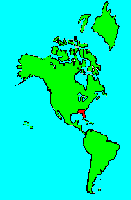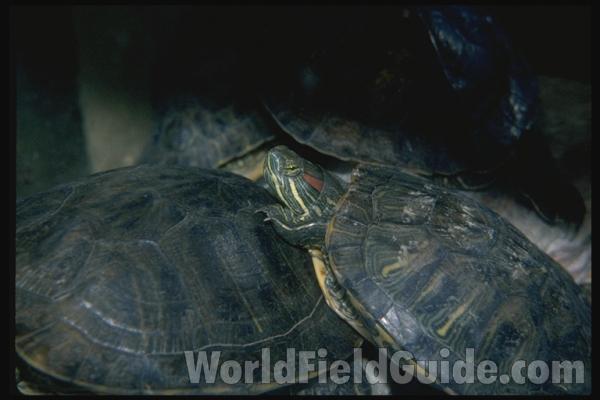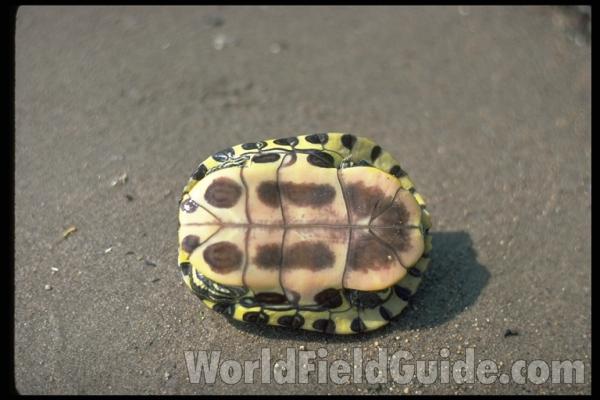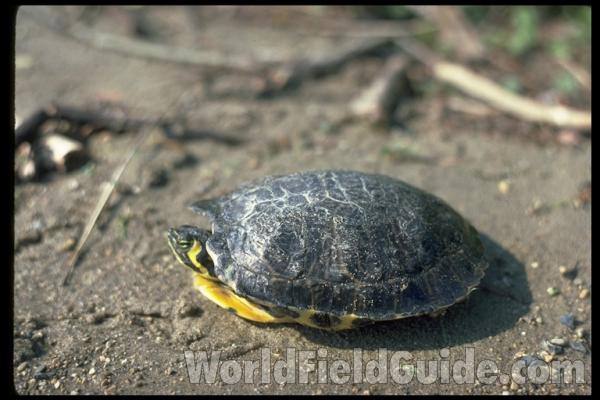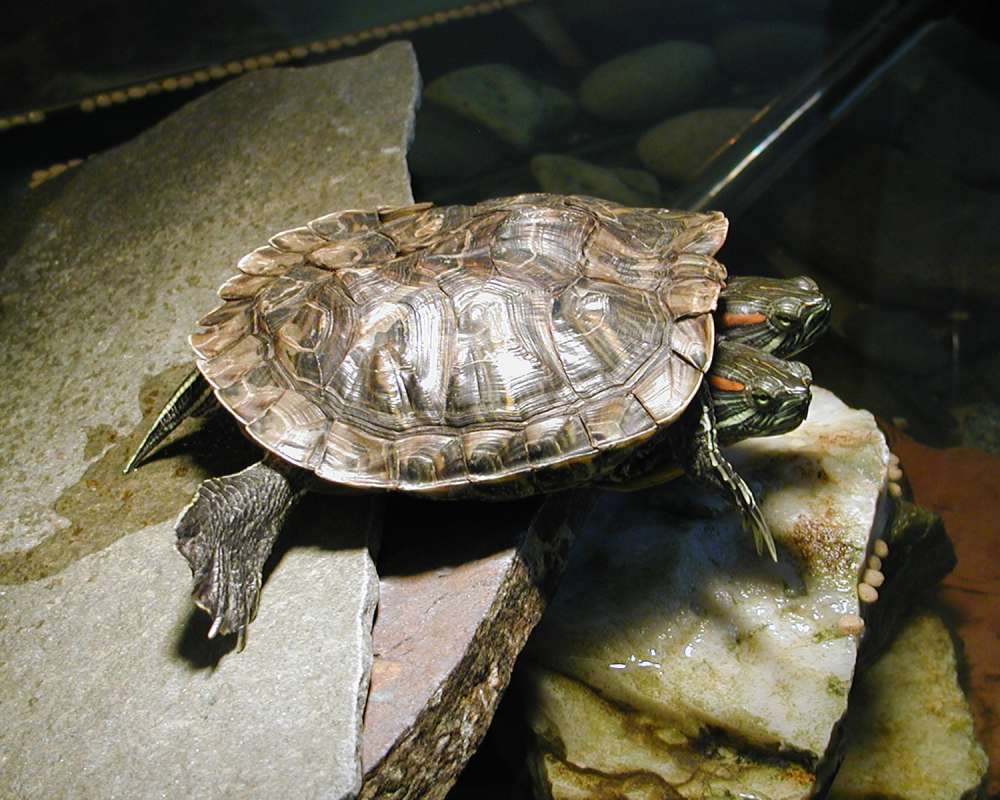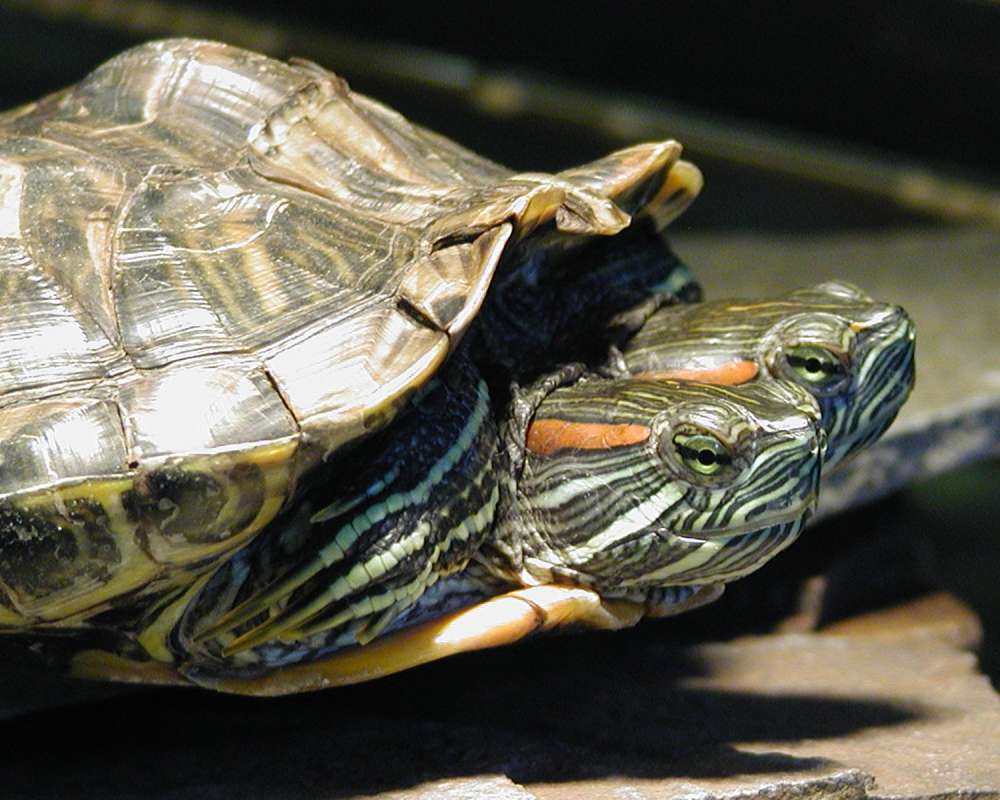SPECIES INFO
Pond Slider, Yellow Bellied Turtle, and Red Ear (Pseudoemys scripta to Trachemys scripta) is found from Virginia to Oklahoma and south to Brazil. The large head stripe behind the eye helps identify this species which can be up to eleven inches in length. There are numerous subspecies including the following four found in the United States:
Scientific Name - (Common Name) - - General Range
C.s.scripta (Yellow Bellied Turtle) - Virginia to N. Florida
C.s.elegans (Red Eared Turtle) - Illinois to Gulf
C.s.troostii (Cumberland Turtle) - Kentucky and Alabama
C.s.gaigeae (Big Bend Turtle) - Big Bend Texas and MexicoThe Trachyemys genus of slider turtles is found from North America south through Central America as far south as Argentina. There are at least 6 species in this genus. The members of this genus have an elongated somewhat domed carapace with sharp serrated edges on the trailing edge.
This genus is close to the Pseudemys genus which we have separated herein. The species are:
Trachyemys scripta - North America to Brazil with at least 14 subspecies
Trachyems decorata - Island of Hispaniola
Trachemys decussata - Cuba and Isle of Pines
Trachyemys stejnegeri - Southern Bahamas to Hispaniola
Trachyemys terrapen - Jamaica and maybe Andros
Trachyemys dorbigni - Brazil south into Uruguay, Paraguay, and eastern Argentina.
It has been suggested that the wide ranging T. scripta should be divided into several additional species.
Family Emydidae is well-represented in North America where twenty-seven different species can be found. There is considerable variation in this group which contains the land box turtles and also many different aquatic species.
Following is a list of the twenty-seven known species (*indicates pictured and discussed herein):
SCIENTIFIC NAME--- COMMON NAME - - - GENERAL RANGE---
Chrysemys picta* - (Painted Turtle) - East United States
Clemys guttata* - (Spotted Turtle) - East United States
Clemys marmorata* - (Western Pond - Pacific Coast )
Clemys muhlenbergi* - (Bog Turtle) - East United States
Clemys insculpta - (Wood Turtle) - East United States
Deirochelys reticularia* - (Chicken Turtle) - Southeast United States
Emydoidea blandingi* - (Blandings Turtle) - Central United States
Graptemys barbouri - (Barbour's Map) - Gulf Coast
Graptemys caglei - (Cagle's Map) - South Central Texas
Graptemys flavimaculata - (Yellow Blotched) - Mississippi and Alabama
Graptemys geographica* - (Map Turtle) - East United States
Graptemys kohni* - (Miss. Map Turtle) - Mississippi River Basin
Graptemys nigrinoda - (Black Knob Sawback) - Alabama and Mississippi
Graptemys oculifera - (Ringed Sawback) - Mississippi and Louisiana
Graptemys ouachitensis - (Ouachita Map) - Central United States
Graptemys pseudogeograph* - (False Map)- Mississippi River Basin
Graptemys pulchra - (Alabama Map) - Gulf Coast
Graptemys versa - (Texas Sawback) - Central Texas
Malaclemys terrapin* - (Diamond Back) - Brackish east United States
Pseudemys alabamensis - (Alabama Red Belly) - Gulf Coast
Pseudemys concinna - (River Cooter) - Virginia to New Mexico
Pseudemys floridana* - (Cooter) - Eastern/southern United States
Pseudemys nelsoni* - (Florida Red Belly) - Florida
Pseudemys rubriventris - (Red Bellied Turtle) - East United States
Pseudemys scripta* - (Pond Slider) - Southeast United States to Brazil
Terrapene carolina* - (Box Turtle) - Maine to Texas
Terrapene ornata* - (Ornate Box) - Illinois to Mexico
The number of species in each genus above is summarized below:
Chrysemys - (1)
Clemys - (4)
Deirochelys - (1)
Emys - (1)
Graptemys - (11)
Malaclemys - (1)
Pseudemys - (6)
Terrapene - (2)
Water and Box Turtle family (Emydidae) is found frequently in North America. Representatives are also found in Europe, South America, and Asia. This group contains most of the familiar freshwater turtles of the world. Ernst and Barbour counted 33 genera with 91 different species.
Turtle and Tortoise group (Order Chelonia) are among the most primitive reptiles. They are egg-laying creatures characterized by having four legs, a tail, and two shells each made up of many scales that are joined together. There are about two hundred and fifty species of turtles in the world. Carl Ernst and Roger Barbour published a book entitled "Turtles of the World" by the Smithsonian Press in l989. This work covers all of the known species. The authors note that there are two hundred and fifty-seven species of living turtles. Many of these species are pictured and discussed here.
The following overview of the various families included in the Turtle Order is based on the aforementioned publication:
SCIENTIFIC NAME - COMMON NAME - NUMBER OF SPECIES
Pelomedusidae - Side Necked - 23 species
Chelidae - Side Necked - 36 species
Kinosternidae - Mud and Musk - 22 species
Dermatemydidae - River Turtle - 1 species
Carettochelyidae - Pig Nose - 1 species
Trionychidae - Soft Shelled - 22 species
Dermochelyidae - Leatherback - 1 species
Cheloniidae - Sea Turtles - 6 species
Chelydridae - Snapping turtles - 2 species
Platysternidae - Big Headed - 1 species
Emydidae - Pond and Box - 91 species
Testudinidae - Tortoises - 50 species
256 total species
While the above counts are currently reliable, they will be impacted by findings as research continues. For example, the exact count of the species of tortoises in the Galapagos and placement of the Florida Snapping Turtle might change these counts.
Reptiles (Class Reptilia) are an ancient group of scaled chordates. These scales may be permanently joined, as in the turtles, or flexible, as in the snakes. Reptiles are land-based. Their eggs are laid on land and the young are air breathing.
In the Great Big Book of Snakes and Reptiles published in 2014, they noted that there are more than 7,000 species of reptiles alive today.
Backboned Animals (Phylum Chordata) are the most advanced group of animals on earth. These animals are characterized by having a spinal cord or backbone. Most members have a clearly defined brain that controls the organism through a spinal cord. Fish, amphibians, reptiles, birds, and mammals are in this phylum.
Currently, some taxonomists believe that the fish should be divided into two groups (sharks and regular fishes) and that there are some other primitive groups in the phylum such as hagfish or lampreys.
Animal Kingdom contains numerous organisms that feed on other animals or plants. Included in the animal kingdom are the lower marine invertebrates such as sponges and corals, the jointed legged animals such as insects and spiders, and the backboned animals such as fish, amphibians, reptiles, birds, and mammals.
